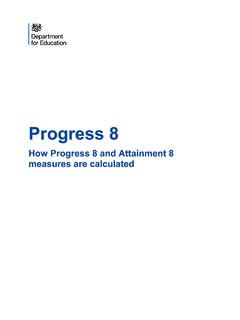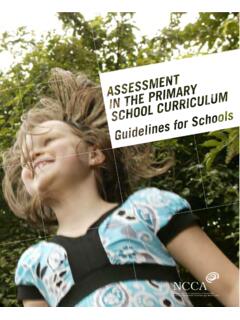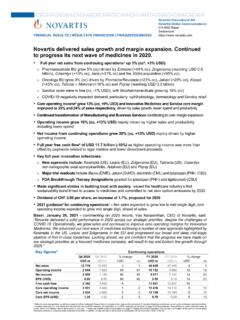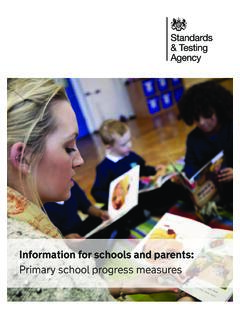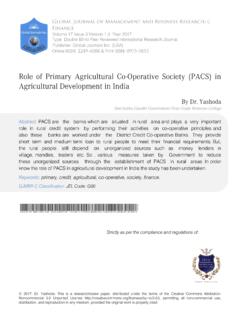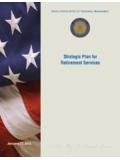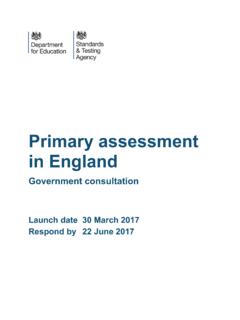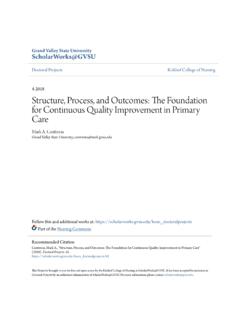Transcription of Primary progress measures - GOV.UK
1 Primary progress measures How the Primary progress measures are calculated Primary accountability: summary of new progress measures The new progress measures , introduced in 2016, are a type of value added measure , which means that pupils results are compared to the actual achievements of other pupils nationally with similar prior attainment. This type of progress measure rewards schools for making progress with all of their pupils, whether they are low, middle or high attainers. Any increase in attainment achieved by each pupil will be reflected in the school s progress scores. They are fairer to schools in challenging circumstances, as they recognise a school that is doing a good job with an intake with poor prior attainment. How we calculate progress measures The progress measures compare pupils key stage 2 results to those of other pupils nationally with similar prior attainment.
2 Our first step is to put all pupils nationally into groups based on their key stage 1 results, so that we have groups of pupils who have similar starting points to each other. We do this by working out a pupils average performance at key stage 1 across reading, writing and mathematics. We allocate points to key stage 1 teacher assessments, as set out in the table below. Key stage 1 point scores for all subjects National curriculum teacher assessment level Point score equivalent Level 4 27 Level 3 21 Level 2A 17 Level 2B or undifferentiated Level 2 15 Level 2C 13 Level 1 9 We then take the points and create an average point score, which is weighted 50:50 for English and mathematics, as this provides a strong correlation to key stage 2 results in all three subjects English reading, English writing and mathematics.
3 This is done by working out an average score for English (reading and writing) and giving this equal weight alongside mathematics. Pupils are then allocated into prior attainment groups with other pupils who have the same key stage 1 average point score as them. Our second step is to identify a pupil s key stage 2 achievements. For reading and mathematics, key stage 2 test results are reported as scaled scores between 80 and 2 1201. The scaled score for each subject is used as the pupil s key stage 2 outcome in the progress score calculation. For writing progress scores, pupils are allocated points for each of the three teacher assessment categories at key stage 2: working towards the expected standard 91; working at the expected standard 103; and working at a greater depth within the expected standard - 113.
4 Our third step is to calculate an individual pupil s progress scores. progress scores are calculated for individual pupils for the sole purpose of constructing a school s progress score. We will not publish pupils progress scores. We will only publish the school s progress scores. The calculation is as follows: We take the individual pupil s key stage 2 result (for example in reading). We compare this to the national average key stage 2 attainment for pupils with similar key stage 1 average points scores to them. A pupils progress score is the difference between their actual KS2 result and the average result of those in their prior attainment group. If Emily, for example, received 102 in reading at KS2 and the average KS2 reading score for her prior attainment group was 101 - her progress score would be +1.
5 Our final step is to create a school level progress score. We do this by adding together the progress scores of all the pupils in year 6 and dividing by the number of year 6 pupils in the school. We repeat this process for each of reading, writing and maths. Schools will have three progress scores: Average progress in mathematics; Average progress in reading; and Average progress in writing. There is no aggregated (overall) key stage 2 progress score. Interpreting progress scores progress scores will be centred around 0, with most schools within the range of -5 to +5. 1 Scaled scores are also used for the attainment element of the floor standard and coasting definition. The attainment measure is the percentage of pupils reaching the expected standard in reading, maths and writing ( a pupil achieving a scaled score of 100 or more in reading and maths and a teacher assessment in writing of working at the expected standard).
6 3 A score of 0 means pupils in this school on average do about as well at KS2 as those with similar prior attainment nationally. A positive score means pupils in this school on average do better at KS2 as those with similar prior attainment nationally. A negative score means pupils in this school on average do worse at KS2 as those with similar prior attainment nationally. A negative score does not mean that pupils did not make any progress , rather it means they made less progress than other pupils nationally with similar starting points. For example, if a school has a maths score of -4 this would mean that on average pupils in this school achieved 4 scaled scores less than other pupils nationally with similar starting points. School scores should be interpreted alongside their associated confidence intervals.
7 Confidence intervals progress results are calculated for a school based on a specific cohort of pupils. A school may have been just as effective but have performed differently with a different set of pupils. To account for this natural uncertainty 95% confidence intervals around progress scores are provided as a proxy for the range of scores within which each school s underlying performance measure can be confidently said to lie. In addition, the greater the number of students, the smaller the range of the confidence interval. For smaller schools the confidence interval tends to be larger, since fewer pupils are included, and therefore the score could be impacted by performance of an individual pupil more than would be the case in a larger school. We publish the 95% confidence intervals alongside a school s progress scores to reflect this uncertainty and provide context to progress scores of smaller schools.
8 Confidence intervals are presented as two numbers the lower and upper limits within which we are 95% confidence the performance of a school may lie. If the lower confidence limit is greater than zero it can be interpreted as meaning that the school has achieved greater than average progress compared to pupils with similar starting points nationally. Similarly, if the upper confidence limit is below zero, then the school has made less than average progress . Where a confidence interval overlaps zero, this means that the school s progress score is not significantly different from the national average. 4 Crown copyright 2016 This publication (not including logos) is licensed under the terms of the Open Government Licence except where otherwise stated. Where we have identified any third party copyright information you will need to obtain permission from the copyright holders concerned.
9 To view this licence: visit email write to Information Policy Team, The National Archives, Kew, London, TW9 4DU About this publication: enquiries download Reference: DFE-00253-2016 Follow us on Twitter: @educationgovuk Like us on Facebook: 5










